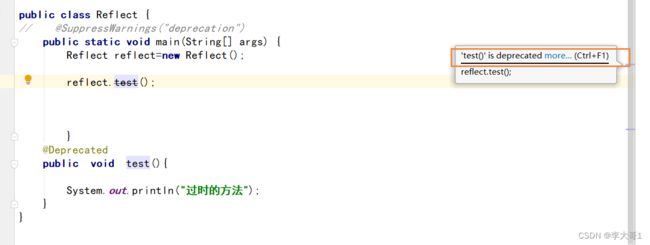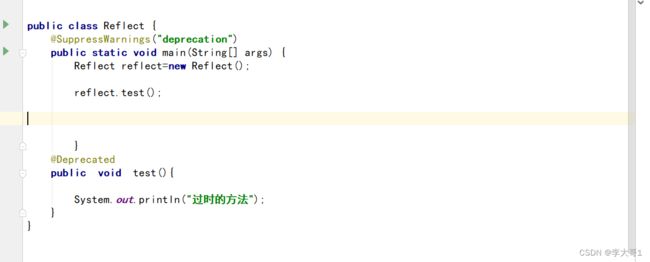java注解详解
1 什么是JAVA注解
- java注解又叫java标注,是jdk1.5引入的一种注释机制;
- java语言的类、方法、属性、参数、包都可以被标注,与javadoc不同,java的注解,在编译时候可以嵌入到字节码文件中,注解可以被JVM虚拟机可以保存,被JVM虚拟机读取。
2 JAVA注解的分类
- java内置注解一个有10个
2.1 代码注解
标注在代码里面的注解,称为代码注解
| 注解 | 描述 |
|---|---|
| override | 标记在子类中重写了父类的方法,如果不是则会报错 |
| deprecated | 标记此方法已经过时了 |
| suppressWarnings | 忽略注解声明的警告 |
2.2 元注解
- 元注解可以理解为注解的注解(如果不能理解可以去看下元数据)
| 注解 | 描述 |
|---|---|
| retention | 标记注解怎么保存 |
| documented | 使用此注解可以让注解保存到javadoc文档中 |
| target | 标记注解的作用域 |
| Inherirted | 标记注解有继承性 |
2.3 新增的注解
| 注解 | 描述 |
|---|---|
| SafavarArgs | 忽略方法或者构造方法的参数为泛型所产生的警告 |
| FuntionalInterface | 标注一个函数性接口 |
| repeatable | 标识某注解可以在同一个声明上使用多次 |
3 JAVA注解三大类
- 每一个annotation都有多个elementType和唯一的一个retentionPolicy(可能这个大家不是很理解,往下看)
3.1 Annotation接口
package java.lang.annotation;
public interface Annotation {
boolean equals(Object obj);
int hashCode();
String toString();
Class<? extends Annotation> annotationType();
}
3.2 ElementType枚举
public enum ElementType {
TYPE, //在接口、类、枚举上声明注解
METHOD,//在方法上声明注解
FIELD,//在字段上声明注解
PARAMETER,//在参数上声明注解
LOCAL_VARIABLE,//在局部变量上声明注解
PACKET,在包上声明注解
CONSTRUCTOR,//在构造方法上声明注解
ANNOTATIONTYPE,//在注解类型上声明注解
}
3.3 RtentionPolicy枚举
public enum RtentionPolicy {
SOURCE, //注解信息存在代码的编译过程,编译结束,注解结束
CLASS, //注解信息保存在字节码文件中
RUNTIME //注解信息保存在字节码文件中,并可以被JVM虚拟机读取
}
4 举例SuppressWarnings详解
@Doucumented
@Target({TYPE, FIELD, METHOD, PARAMETER, CONSTRUCTOR, LOCAL_VARIABLE})
@Retention(RetentionPolicy.SOURCE)
public @interface SuppressWarnings {
String[] value();
}
- @Doucumented代表的是SuppressWarnings注解可以保存javadoc文档里面的
- @Target({TYPE, FIELD, METHOD, PARAMETER, CONSTRUCTOR, LOCAL_VARIABLE}) 表示的是该注解可以作用域。
- @Retention(RetentionPolicy.SOURCE) 表示注解仅仅在存在编译期间,编译结束则消失
- String[] value();表示SuppressWarnings 有多个值;
SuppressWarnings的常用关键字
| 关键字 | 描述 |
|---|---|
| deprecation | 忽略使用不被赞成、过时所产生的警告 |
| unchecked | 忽略集合中没有声明类型的所产生的警告 |
| fallthrouth | switch程序块,忽略下一种情况没有break的情况 |
| path | 忽略类地址、源路径不存在的警告 |
| serial | 序列化的时候,忽略类中缺少serialVersionUUid警告 |
| finally | 忽略finally语句块不能正常执行的的警告 |
| all | 忽略以上所有的警告 |
5 举例Inherited详解
@Documented
@Retention(RetentionPolicy.RUNTIME)
@Target(ElementType.ANNOTATION_TYPE)
public @interface Inherited {
}
- @Doucumented代表的是Inherited注解可以保存javadoc文档里面的
- @Target(ElementType.ANNOTATION_TYPE) 表示的是该注解可以作用域是annotation。
- @Retention(RetentionPolicy.RUNTIME)表示注解保存在class文件中,并可以被JVM虚拟机读取
- 被Inherited 注解的注解具有继承性
示例1不被Inherited 修饰的注解
1、编写一个注解
package reflect;
import java.lang.annotation.Documented;
import java.lang.annotation.Retention;
import java.lang.annotation.Target;
import static java.lang.annotation.ElementType.*;
import static java.lang.annotation.RetentionPolicy.RUNTIME;
//@Inherited
@Documented
@Retention(RUNTIME)
@Target({TYPE,FIELD,METHOD})
public @interface AnnnotationOne {
}
2、编写一个父类
package reflect;
@AnnnotationOne
public class Person {
}
3、编写一个子类
package reflect;
public class Teacher extends Person {
public static void main(String[] args) {
Class<Teacher> teacherClass = Teacher.class;
boolean annotationPresent = teacherClass.isAnnotationPresent(AnnnotationOne.class);
System.out.println(annotationPresent);
}
}
响应

示例2被Inherited 修饰的注解
1、编写一个注解
package reflect;
import java.lang.annotation.Documented;
import java.lang.annotation.Inherited;
import java.lang.annotation.Retention;
import java.lang.annotation.Target;
import static java.lang.annotation.ElementType.*;
import static java.lang.annotation.RetentionPolicy.RUNTIME;
@Inherited
@Documented
@Retention(RUNTIME)
@Target({TYPE,FIELD,METHOD})
public @interface AnnnotationOne {
}
2、编写一个父类
package reflect;
@AnnnotationOne
public class Person {
}
3、编写一个子类
package reflect;
public class Teacher extends Person {
public static void main(String[] args) {
Class<Teacher> teacherClass = Teacher.class;
boolean annotationPresent = teacherClass.isAnnotationPresent(AnnnotationOne.class);
System.out.println(annotationPresent);
}
}
- 从2个示例可以看出被注解Inherirte标注的注解具有继承性。
6 反射注解
package reflect;
import java.lang.annotation.Annotation;
public class Teacher extends Person {
public static void main(String[] args) {
//获取Teacher的class对象
Class<Teacher> teacherClass = Teacher.class;
//获取父类的class对象
Class<? super Teacher> superclass = teacherClass.getSuperclass();
//获取指定的注释对象
AnnnotationOne Annotation = superclass.getAnnotation(AnnnotationOne.class);
//获取注解的值
String[] value = Annotation.value();
for (String a :value){
System.out.println(a);
}
System.out.println("=================================");
Annotation[] annotations = superclass.getAnnotations();
for (Annotation annotation:annotations){
System.out.println(annotation);
}
}
}





